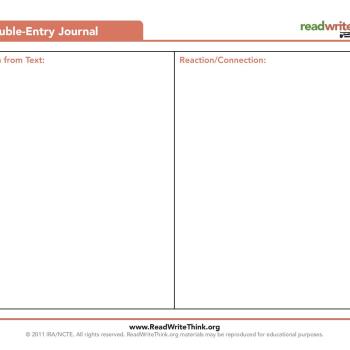Double-Entry Journal

About this printout
This printout helps students record ideas and situations from texts in one column, and their reactions in the second, thus making a connection between the text and themselves, another text, or the world.
Teaching with this printout
Using the Making Connections Posters as visual aids, remind students of the three types of connections: Text-to-Self Connection, Text-to-Text Connection, and Text-to-World Connection. Explain how readers often make connections to a story to help them better understand the text.
During and/or after the reading of a text, display a blank copy of the Double-Entry Journal to demonstrate how to use this printout to make connections with the text.
- In the first column, students should choose a quote or situation from the text that they can relate/react to.
- In the second column, students should record their thoughts or reaction.
Reinforce the fact that the thoughts/reactions that students record should make a connection between the text and themselves (text-to-self), another text (text-to-text), or the world (text-to-world). Use chart paper or an overhead projector to model the process so that all students can see your reactions and reflections and follow along as you complete the Double-Entry Journal.
After students have had ample time to record their connections, ask students to share them aloud. Remind students to explain which of the three types of connections they are making, and also to make sure they are making connections that are productive and enhance their understanding of the text.
More ideas to try
- Ask students to reflect and respond to the following prompt on the back of their Double-Entry Journal: Choose one connection and explain specifically how it helped you better understand what you were reading. You may wish to write this statement on the board or chart paper for students to see while writing their answers.
- Have students use the Connection Web printout to flesh out one of their connections which they would like to explore further. After adding supporting details from the text to support their connection, students can use the Connection Web to assist them with writing an essay or creating a project about their connection.